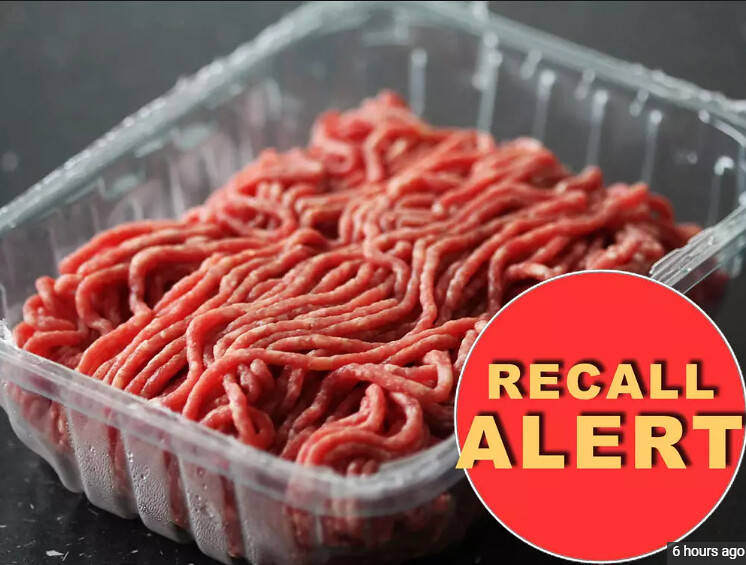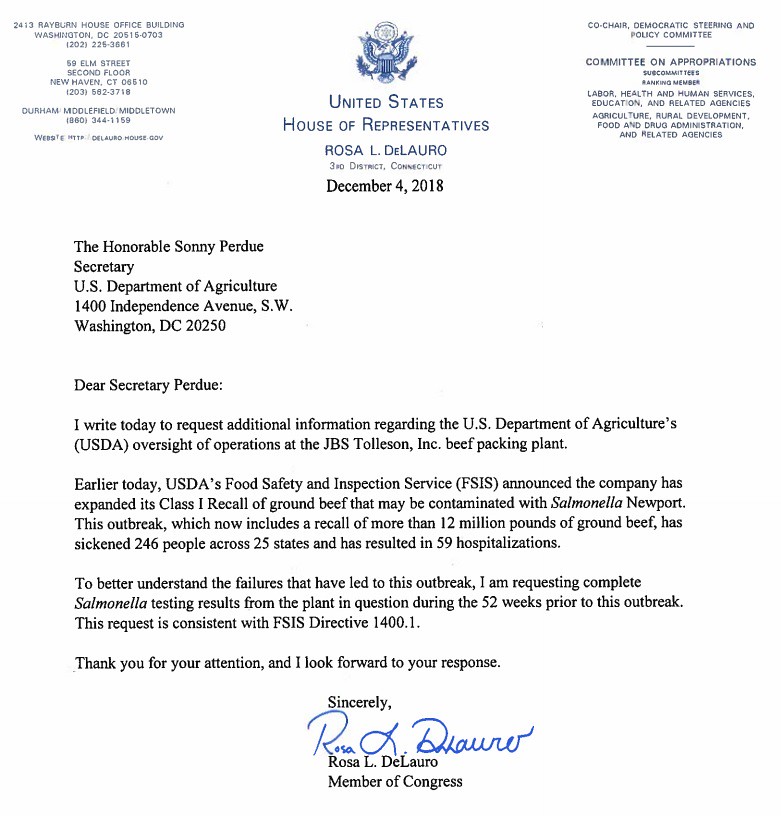Source: Cooking Light
Amid the beef recall hitting the United States, one cannot help but think about the post I wrote recently regarding the unkown fact that bacteria is not checked in meat/poultry products after the products leave the warehouse by the Food Safety Inspection Service. As I alluded to, corporations left on their own to conduct inspections is a path toward outbreaks. Not all corporations are offenders. Although, the beef recall is indicative the lack of inspections on part of a corporation --
Congress has now been inserted into the recall based on the number of people affected by the tainted (salmonella tainted) beef. Congresswomen Rosa DeLauro sent a letter of inquiry to Agricultural Secretary Sonny Purdue shown below:
Source: Congress
The following message is written on the letter shown above:
Dear Secretary Purdue:
I write today to request additional information regarding the U.S. Department of Agriculture's (USDA) oversight of operation at the JBS Tolleson, Inc. beef packing plant.
Earlier today, USDA's Food Safety and Inspection Service (FSIS) announced the company has expanded its Class 1 Recall of ground beef that may be contaminated with Salmonella Newport. This outbreak, which now includes a recall of more than 12 million pounds of ground beef, has sickened 246 people across 25 states and has resulted in 59 hospitalizations.
To better understand the failures that have led to this outbreak, I am requesting complete Salmonella testing results from the plant in question during the 52 weeks prior to this outbreak. This request is consistent with FSIS Directive 1400.1.
Thank you for your attention, and I look forward to your response.
Sincerely,
Rosa L. DeLauro
Member of Congress
I am glad to see that congress has now been involved in the matter. Especially since the inquiry comes against the backdrop of a recently released report by the Food Safety Inspection Service on the efficacy of poultry inspections in a variety of poultry plants around the United States. The report shows that a sizable portion of the poultry plants have earned less than stellar (alarming) grades on their ability to inspect for Salmonella (along with other bacteria) in the outgoing products.
Conclusion...
The issue is a moving target -- an ongoing situation -- which is changing and will be updated on this site when news pops up. Food safety from a contamination standpoint is just as alarming as food safety from ingredient safety is to me. Each of us deserve to understand the regulations and checks (and balances) which exist in government (federal down through local) to provide a safety and healthy product to the consumer.
Stay vigilant and educate yourself on the safety of the world around yourself. Education is the best weapon to combat any problem which plagues society. Unfortunately, not enough education is accomplished on this matter at professional institutions. Therefore, the responsibility lies within each of us to do the work. Stay tuned.
Related Blog Posts:
One Unknown Fact Which Should Cause Consumers To Be Careful About Handling Meat Before Cooking!
How Effective Are Poultry Corporations At Reducing Salmonella In Their Products?
Ralph Nader: Post Election -- Next Step -- Open Up The Existing Secretive Congress
New trend in the Thanksgiving Holiday for 2018? Smaller Turkeys?
A Forecaster Predicts That Hurricane Florence Will Drop Enough Rain To Fill 18,400 Mercedes-Benz Superdomes
Hurricane Harvey Drops Enough Rain On Houston To Fill 560 Dallas Cowboy Stadiums
How Much Water Is Contained In All Oceans Around The Globe?
Storm Raises Water Level In Lake Cachuma By 31 feet, How Much Water Is That?
How To Make Sense Of Water Flowing At 100,000 Cubic Feet Per Second
Can 11 Trillion Gallons Of Water Fill 14,000 Dallas Cowboys Stadiums?
How Much Rain Did The East Coast Receive From Hurricane Matthew?
How Much Rain Did Haiti Really Receive?
How Much Rainfall Has Dropped On Louisiana?
How Big Was The "Water Bomb" Of Rainfall In Macedonia?
How Much Rain Did Huauchinango (Mexico) receive?
How Much Rain Did Elliot City (Maryland) Really Receive?
If The Mosul Dam Breaks, The City Of Mosul Would Be Under 65 Feet Of Water?
What is the volume of water in a few inches of rain?
Volume of Waste in the Mine Spill (in Brazil) Equivalent to 78 Deepwater Horizon Oil Spills
Hurricane Harvey Drops Enough Rain On Houston To Fill 560 Dallas Cowboy Stadiums
How Much Water Is Contained In All Oceans Around The Globe?
Storm Raises Water Level In Lake Cachuma By 31 feet, How Much Water Is That?
How To Make Sense Of Water Flowing At 100,000 Cubic Feet Per Second
Can 11 Trillion Gallons Of Water Fill 14,000 Dallas Cowboys Stadiums?
How Much Rain Did The East Coast Receive From Hurricane Matthew?
How Much Rain Did Haiti Really Receive?
How Big Was The "Water Bomb" Of Rainfall In Macedonia?
How Much Rain Did Elliot City (Maryland) Really Receive?
If The Mosul Dam Breaks, The City Of Mosul Would Be Under 65 Feet Of Water?
What is the volume of water in a few inches of rain?
Volume of Waste in the Mine Spill (in Brazil) Equivalent to 78 Deepwater Horizon Oil Spills







